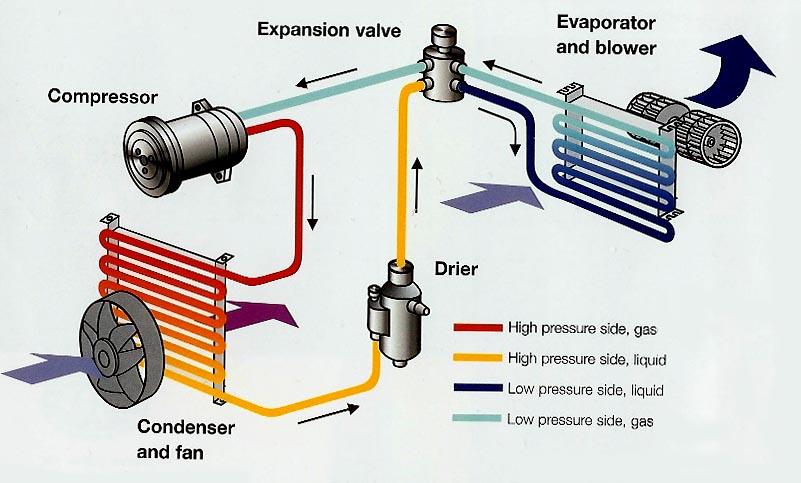
How a Car A/C Works (or Doesn’t)
I'm sure at one time or another we all have found ourselves sitting in our vehicle on the hottest day of the summer with cold air blowing from the A/C system.
Sure, your car’s A/C (if it’s working correctly) turns hot air cold, which can feel miraculous on a sunny summer afternoon. But the way it cools that air isn’t as complicated as some people think.
Parts of a Car A/C
There are five main parts of a car A/C:
- Compressor
- Condenser
- Thermal expansion valve or orifice tube
- Evaporator
- Accumulator or receiver/drier
Each of the parts is connected by tubing or hoses to form a closed loop. Through that loop runs refrigerant, which is what really does the work of cooling down the air.
The Refrigeration Cycle (Round and Round We Go)
The best way to explain how a car air conditioner works is to describe what happens to the refrigerant as it travels around the loop and through the different parts.
Since we’re talking about a continuous circle, there’s no official start or end point; everything happens at once. But we’ll start our description at the compressor; since that is the part you can most easily see when you pop the hood.
Step 1: Compressor
The compressor is a simple pump, which pushes the refrigerant through the loop. As it pumps the refrigerant, which at this point is a gas, it also compresses it (hence the name) and causes it to be under high pressure. The high pressure also causes the refrigerant to become very hot—hotter than the summer air outside.
Step 2: Condenser
The hot, high-pressure refrigerant flows through the high-pressure tube to the condenser. The condenser is in front of the car’s radiator, looks like the radiator, and basically does the same thing as the radiator: it uses the air flowing through it to cool the refrigerant. The hot refrigerant, which is normally a gas, condenses into a liquid as it cools (which is why it’s called a “condenser”).
Step 3: Thermal Expansion Valve or Orifice Tube
The now-liquid refrigerant flows through high-pressure tubing back toward your car’s dash, where it passes through a small valve. Depending on your car, this valve is called either a thermal expansion valve or an orifice tube it then changes back to a low-pressure gas.
The valve allows only a small amount of refrigerant through at a time, and also relieves the pressure created by the compressor. A funny thing happens when you suddenly reduce the pressure: the refrigerant becomes very cold. (Fun fact: besides making air conditioning possible, this also explains how Superman’s freeze breath works.)
Step 4: Evaporator
The cold, low-pressure refrigerant then goes into the evaporator, which is a radiator much like the condenser and is located in your dash. But since the refrigerant is cold now, it’s the air that is cooled by the radiator, rather than the radiator being cooled by the air. An electric blower fan pushes the cold air through the vents and into the passenger cabin.
Step 5: Accumulator or Receiver/Drier
Every car A/C system will also have either an accumulator or a receiver/drier. A receiver/drier will be located after the condenser, while an accumulator will be after the evaporator. Whichever device your car has, its function is to filter the refrigerant and absorb any moisture that might be in the system.
After completing the loop, the refrigerant is then sucked back into the compressor through the low-pressure tube, starting the cycle all over again.
What Could Possibly Go Wrong?
Understanding how the A/C system works can help you understand what causes it to sometimes not work.
If your A/C is blowing hot or lukewarm air, the most likely culprit is low refrigerant. That’s because, except for the compressor, there aren’t really any moving parts in an A/C system; the refrigerant is the moving part.
Since it’s a closed loop, your A/C doesn’t ever “use up” refrigerant. And refrigerant can’t “wear out” any more than you could “wear out” water or air. The only way your refrigerant can be low is if it has leaked out.
So, as long as your compressor is working, a broken car A/C can usually be fixed by repairing the leak and refilling the system with R-134a refrigerant. An A/C dye is put into the system and a UV Black light is used to find where the dye is leaking. Another method of leak detection is to use an A/C sniffer. This is an electronic probe that senses the R134A and will alert the technician when a leak is present.
If you have any questions about how your car A/C works (or why it’s not working) give us a call at Custom Auto Care 402-467-3307.
#AC #R134A #HOTAIR